
Roofing warranties can often be a complex subject for homeowners, yet they are crucial for protecting their investments. As a roofing business, it’s important to educate your clients about the different types of warranties available, what they cover, and how to navigate them. Here’s what your roofing business clients need to know:
1. Types of Roofing Warranties
- Manufacturer's Warranty: This warranty covers defects in the roofing materials. It guarantees that the materials will perform as expected under normal conditions.
- Workmanship Warranty: Provided by the roofing contractor, this warranty covers installation errors or issues that arise due to poor workmanship.
- Extended Warranty: Some manufacturers offer extended warranties that provide additional coverage beyond the standard terms.
2. Coverage Details
- Material Defects: Typically, manufacturer's warranties cover defects in the materials, but they may not cover labor costs for replacing defective materials.
- Installation Errors: Workmanship warranties address problems that result from improper installation techniques.
- Full-System Coverage: Some warranties offer comprehensive coverage that includes both materials and labor.
3. Limitations and Exclusions
- Maintenance Requirements: Many warranties require regular maintenance to remain valid. Clients should keep detailed records of all maintenance activities.
- Weather Damage: Damage from severe weather events (e.g., hurricanes, tornadoes) is often excluded from standard warranties.
- Improper Installation: If the roof was installed by an unqualified contractor, the warranty might be voided.
4. Transferring Warranties
- Ownership Transfer: Some warranties are transferable to new homeowners, which can be a selling point for clients looking to move in the future.
- Conditions for Transfer: It’s important to understand any conditions or fees associated with transferring a warranty to a new owner.
5. Making a Warranty Claim
- Documentation: Clients should keep all receipts, warranties, and maintenance records in a safe place.
- Timely Reporting: Report any issues as soon as they are noticed to avoid further damage and complications with the warranty claim.
- Professional Inspections: Having a professional inspection can help in diagnosing issues accurately and ensuring that the claim process goes smoothly.
Conclusion
Educating your clients about roofing warranties not only helps them make informed decisions but also builds trust in your roofing business. Clear communication about what warranties cover and how to maintain them can prevent misunderstandings and ensure that your clients feel secure in their investments. Share this blog with your clients to help them navigate the complexities of roofing warranties with confidence.